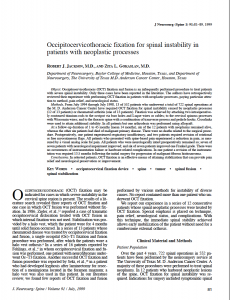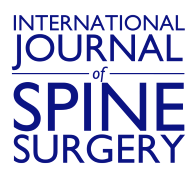
Abstract
OBJECT: Occipitocervicothoracic (OCT) fixation and fusion is an infrequently performed procedure to treat patients with severe spinal instability. Only three cases have been reported in the literature. The authors have retrospectively reviewed their experience with performing OCT fixation in patients with neoplastic processes, paying particular attention to method, pain relief, and neurological status.
METHODS: From July 1994 through July 1998, 13 of 552 patients who underwent a total of 722 spinal operations at the M. D. Anderson Cancer Center have required OCT fixation for spinal instability caused by neoplastic processes (12 of 13 patients) or rheumatoid arthritis (one of 13 patients). Fixation was achieved by attaching two intraoperatively contoured titanium rods to the occiput via burr holes and Luque wires or cables; to the cervical spinous processes with Wisconsin wires; and to the thoracic spine with a combination of transverse process and pedicle hooks. Crosslinks were used to attain additional stability. In all patients but one arthrodesis was performed using allograft. At a follow-up duration of 1 to 45 months (mean 14 months), six of the 12 patients with neoplasms remained alive, whereas the other six patients had died of malignant primary disease. There were no deaths related to the surgical procedure. Postoperatively, one patient experienced respiratory insufficiency, and two patients required revision of rotational or free myocutaneous flaps. All patients who presented with spine-based pain experienced a reduction in pain, as measured by a visual analog scale for pain. All patients who were neurologically intact preoperatively remained so; seven of seven patients with neurological impairment improved; and six of seven patients improved one Frankel grade. There were no occurrences of instrumentation failure or hardware-related complications. In one patient a revision of the instrumentation was required 13.5 months following the initial surgery for progression of malignant fibrous histiosarcoma.
CONCLUSIONS: In selected patients, OCT fixation is an effective means of attaining stabilization that can provide pain relief and neurological preservation or improvement.
To Read The Full Article Click Here
PMID: 1019373






